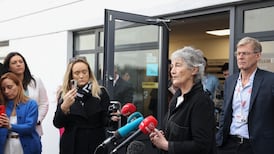Under the twinkling lights of 150 crystal chandeliers running the whole length of a white dining table set for 500 guests, the Belgian designer Dries van Noten marked his 50th fashion show yesterday in Paris with breathtaking extravagance and style.
A vast industrial boiler factory on the outskirts of the city was the surreal location for the fairytale presentation in which the dining table was transformed into a runway at midnight. As a piece of stagecraft, it could hardly have been bettered.
The 46-year-old independent designer, who started his business 20 years ago, is no Cinderella of the fashion industry and can certainly afford to celebrate. Known for his Bohemian style and love of rich materials, colour and embroidery, he sells 100,000 pieces each season and is stocked in over 400 stores worldwide including Dublin.
His principal form of communication is the catwalk rather than lavish media advertising, and his shows tend to have romantic, theatrical settings in keeping with the mood and spirit of each collection. This one, driven by the music from Carmen, was a powerful display of all the elements that have made his clothes so desirable and successful. Full skirts with Hungarian-style embroidery and the kind of easy layering associated with ethnic dress were signature items.
Glittering with sequins, embellished with embroidery or decorated with print, they swished out under shrunken jackets, close-fitting waistcoats or belted coats, a clever mix of sharp tailoring, gentle layering and fluidity.
Dresses in sweet milkmaid prints. or simple black smocked chiffon, gave way to bolder striped flamenco skirts. It was a collection that gave a flavour of soft new womanly sumptuousness.
Another Belgian designer, Veronique Branquinho, known for dark, mannish tailoring, chose a rundown l9th-century theatre, the Elysée Montmartre, now a music venue and all-night dance club, for her spring-summer presentation.
Models were parked on the stage in peacock chairs like shop dummies who had risen from their sedentary tableaux to parade pale blue silk tweed jackets with leather elbow patches or casual trousers worn with huge crochet or fringed patchwork shawls - classy, commercial styles.
Much play was made of brown; brown jersey wrap dresses, some hooded and worn in an offhand way with drawstring jackets, others teamed with blue chiffon skirts attempted a more feminine approach, but seemed lacklustre for spring. A finale of models in gold swimsuits back in their chairs did little to quicken the pulse or the spirits.









